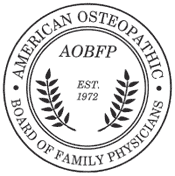What is Early Entry Initial Certification?
The American Osteopathic Board of Family Physicians (AOBFP) Early Entry Initial Certification (EEIC) program is designed for osteopathic residents who want to maintain their osteopathic distinctiveness within a single accreditation system extended into their certification.
The EEIC program is available for osteopathic family medicine residents who want to intentionally set themselves apart and “choose excellence,” as an osteopathic family physician, integrating the four osteopathic core principles into their care and treatment of patients.
It is also available to allopathic graduates who satisfy the requirements of additional osteopathic training. The AOBFP EEIC program is an excellent option for the osteopathically-trained medical student who has been matched into an ACGME family medicine program that does not have an osteopathic focus. It takes place in the spring of PGY3 each year.

Explore Frequently Asked EEIC Questions:
- An osteopathic family medicine resident.
- A resident (allopathic or osteopathic) who is enrolled in an ACGME osteopathically-recognized family medicine residency program.
- An allopathic resident who is enrolled in a non-osteopathically-recognized ACGME-accredited family medicine residency program that has completed fifty (50) hours of OMT/OPP training.
All participants must have taken two (2) AOBFP In-Service Examinations (ISE) during their residency.
Yes, an allopathic resident who is in an ACGME osteopathically-recognized residency or who has completed 50 hours of OMT/OPP approved training and has taken two (2) AOBFP In-Service Examinations (ISE) during their residency program may participate.
Yes, residents from new osteopathically recognized programs are eligible for the EEIC if they have taken two (2) AOBFP In-Service Examinations (ISE) during their residency program. Regarding allopathic residents who are in programs that were dually accredited but are no longer osteopathically recognized, those individuals would be eligible if they complete fifty (50) hours of OMT/OPP training and have taken two (2) AOBFP In-Service Examinations (ISE) during their residency program.
- Complete two AOBFP In-Service Examinations (ISE) during your residency program.
- Register for the EEIC program. Registration information can be found here.
- Take and pass the AOBFP Early Entry Initial Certification Examination during your last year of residency.
- Complete a three-year AOA/ACGME-approved residency in family medicine.
No, the AOBFP In-Service Examinations (ISE) is required for the EEIC Program. required for the EEIC program. If a residency program does not support the ISE, individuals may contact the American College of Osteopathic Family Physicians (ACOFP) directly and register for the ISE. Contact Judy Schwellenbach.
The exam will be offered in the spring of the PGY3. While residents will not be officially conferred until after successful completion of PGY3 (and passing the EEIC exam), you will be able to tell future employers you have passed the AOBFP certification exam earlier in your search process, which could make you more competitive as a potential hire.
No. The ISE is a formative assessment and does not have pass/fail scores, and cannot replace a certification exam. The EEIC exam is designed to measure the competency and knowledge, skills, abilities, and judgments of a qualified osteopathically-certified family practice physician.
To maintain ACGME accreditation, residents across all programs must take a formative assessment (in-service exam) for all three years of residency. To qualify and participate in EEIC, only two attempts at the ISE need to be completed.
No, the only requirement for the program is two independent scores attained in different years of the residency.
The EEIC exam will cover the same content domains as the standard initial certification exam. The content domains are determined by an analysis of practice which is conducted regularly by surveying osteopathic family physicians about their practice. Both exams are designed to measure the competency and knowledge, skills, abilities, and judgments of qualified osteopathic family practice physicians.
The EEIC examination will be shorter in length than the standard initial certification exam, thus providing for less testing time, and will be offered in advance (earlier in the year) so candidates will have performance outcomes sooner than their counterparts. All AOA examinations are psychometrically validated and developed by best practice models for high-stakes testing using recognized industry standards.
Upon satisfying all requirements as outlined by the AOBFP, certification will be granted and the individual will be officially enrolled in OCC. The beginning of the OCC cycle is January 1 of the year following the candidate’s initial certification.
A resident can choose either Osteopathic Certification in Osteopathic Family Medicine & Osteopathic Manipulative Treatment (OMT) or Osteopathic Family Medicine. If a resident chooses the OMT option, the performance exam would only be required at initial certification.
- To reflect your proficiency in osteopathic manipulative medicine and commitment to maintaining the distinctiveness of osteopathic practice.
- To distinguish yourself as a skilled practitioner by achieving a level of mastery in OMM as evaluated by experts in the field.
- Opportunities for ongoing skill development in and applications of OMM are offered and available throughout osteopathic continuous certification.
- The timing is right. The skills and abilities to demonstrate proficiency in OMM are at their peak when completing training.
- Patient assurance of a competent, skilled practitioner as evidenced by the distinct certification.
Yes, an AOA-certified family practice diplomate in good standing (meeting all of the requirements for osteopathic continuous certification) may apply for the OMM option at any point throughout their professional career.
The ACOFP Foundation’s Initial Certification Grant provides grants to third-year residents who sit for both AOBFP’s written (cognitive) and performance (practical) exams. Partial grants may be awarded to residents who do not have complete funding from their program.
- The written examination is $400. (The standard initial certification cost is $550).
- The performance examination is $500. (Travel is required as the exam takes place at the ACOFP Annual Convention)

What is the In-Service Exam
The AOBFP In-Service Exam (ISE), produced and administered by ACOFP, is a formative exam that will fulfill ACGME standard requirements. It also includes an osteopathic component that will fulfill ACGME’s OPP/OMM formative assessment requirement for programs that have Osteopathic Recognition (OR).
.png?sfvrsn=9e7cb149_1)
.png?sfvrsn=cce3cea1_0)
